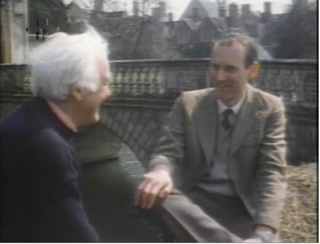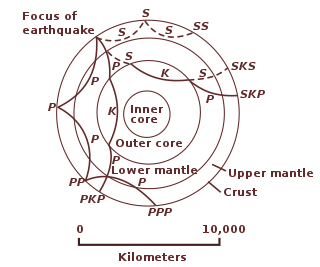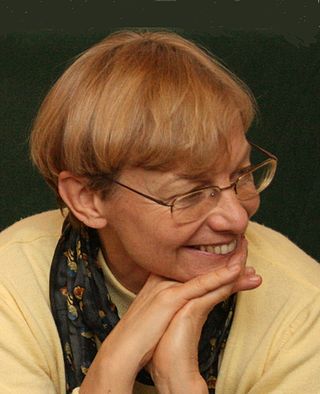Related Research Articles

Geophysics is a subject of natural science concerned with the physical processes and physical properties of the Earth and its surrounding space environment, and the use of quantitative methods for their analysis. Geophysicists, who usually study geophysics, physics, or one of the Earth sciences at the graduate level, complete investigations across a wide range of scientific disciplines. The term geophysics classically refers to solid earth applications: Earth's shape; its gravitational, magnetic fields, and electromagnetic fields ; its internal structure and composition; its dynamics and their surface expression in plate tectonics, the generation of magmas, volcanism and rock formation. However, modern geophysics organizations and pure scientists use a broader definition that includes the water cycle including snow and ice; fluid dynamics of the oceans and the atmosphere; electricity and magnetism in the ionosphere and magnetosphere and solar-terrestrial physics; and analogous problems associated with the Moon and other planets.
Allan Verne Cox was an American geophysicist. His work on dating geomagnetic reversals, with Richard Doell and Brent Dalrymple, made a major contribution to the theory of plate tectonics. Allan Cox won numerous awards, including the prestigious Vetlesen Prize, and was the president of the American Geophysical Union. He was the author of over a hundred scientific papers, and the author or editor of two books on plate tectonics. On January 27, 1987, Cox died in an apparent suicide.

Frederick John Vine FRS was an English marine geologist and geophysicist. He made key contributions to the theory of plate tectonics, helping to show that the seafloor spreads from mid-ocean ridges with a symmetrical pattern of magnetic reversals in the basalt rocks on either side.

Don Lynn Anderson was an American geophysicist who made significant contributions to the understanding of the origin, evolution, structure, and composition of Earth and other planets. An expert in numerous scientific disciplines, Anderson's work combined seismology, solid state physics, geochemistry and petrology to explain how the Earth works. Anderson was best known for his contributions to the understanding of the Earth's deep interior, and more recently, for the plate theory hypothesis that hotspots are the product of plate tectonics rather than narrow plumes emanating from the deep Earth. Anderson was Professor (Emeritus) of Geophysics in the Division of Geological and Planetary Sciences at the California Institute of Technology (Caltech). He received numerous awards from geophysical, geological and astronomical societies. In 1998 he was awarded the Crafoord Prize by the Royal Swedish Academy of Sciences along with Adam Dziewonski. Later that year, Anderson received the National Medal of Science. He held honorary doctorates from Rensselaer Polytechnic Institute and the University of Paris (Sorbonne), and served on numerous university advisory committees, including those at Harvard, Princeton, Yale, University of Chicago, Stanford, University of Paris, Purdue University, and Rice University. Anderson's wide-ranging research resulted in hundreds of published papers in the fields of planetary science, seismology, mineral physics, petrology, geochemistry, tectonics and the philosophy of science.
Keith Edward Bullen FAA FRS was a New Zealand-born mathematician and geophysicist. He is noted for his seismological interpretation of the deep structure of the Earth's mantle and core. He was Professor of Applied Mathematics at the University of Sydney in Australia from 1945 until 1971.
Liviu Constantinescu was a Romanian geophysicist, professor of geophysics, member of the Romanian Academy. He was the cofounder, together with Sabba S. Ștefănescu, of the Romanian school of geophysics.
(Stanley) Keith Runcorn was a British physicist whose paleomagnetic reconstruction of the relative motions of Europe and America revived the theory of continental drift and was a major contribution to plate tectonics.
George Edward Backus is an American geophysicist, best known for his work with J. Freeman Gilbert on inverse methods for geophysical data. He is also notably credited with advancing the dynamo theory on the origin of the Earth's magnetic field.

The following outline is provided as an overview of and topical guide to geophysics:

Kathryn Anne "Kathy" Whaler OBE FRSE FAGU is a professor of geophysics at the University of Edinburgh School of GeoSciences, in the Research Institute of Earth and Planetary Science and is a member of the Solid Earth Geophysics and Natural Hazards Research Group.
Hrvoje Tkalčić is Australian and Croatian scientist (geophysicist) and Professor E2 at the Australian National University in Canberra.
Brian Leslie Norman Kennett is a mathematical physicist and seismologist. He is now a professor emeritus at the Australian National University.
John Henry Woodhouse is an English geophysicist, Emeritus Professor in the Department of Earth Sciences at the University of Oxford.

Barbara A. Romanowicz is a French geophysicist and an expert on imaging the Earth's interior.
Maureen D. Long is an observational seismologist studying mantle and Mesosphere dynamics. She currently serves as a professor at Yale University within the Department of Geology and Geophysics.
Alik Ismail-Zadeh is a mathematical geophysicist known for his contribution to computational geodynamics and natural hazard studies, pioneering work on data assimilation in geodynamics as well as for outstanding service to the Earth and space science community. He is Senior Research Fellow at the Karlsruhe Institute of Technology in Germany.
Catherine G. Constable is an Australian Earth scientist who is a professor at the Scripps Institution of Oceanography. Her research considers palaeo- and geo-magnetism. Constable was awarded the American Geophysical Union William Gilbert Award in 2013 and elected Fellow of the American Association for the Advancement of Science in 2017.
David A. Bercovici is an American geophysicist. He is primarily known for his theoretical explanations of why planet Earth has plate tectonics. He is also known for his development of models of how the Earth's mantle recycles and stores water and how such hydrological processes are involved in Earth's geochemical history.
John Arthur “Jack” Jacobs was a British geophysicist and mathematician, whose primary area of research was geomagnetism. He worked at multiple universities in Canada and the UK, and was awarded the Gold medal of the Royal Astronomical Society in 2002.
References
- ↑ "Prof David Gubbins". University of Leeds. Retrieved 26 April 2018.
- ↑ Richards, Paul G.; Cattermole, Peter (September 1991). "Book Review: Seismology and plate tectonics by David Gubbins". Physics of the Earth and Planetary Interiors. 68 (3–4): 295. Bibcode:1991PEPI...68..295R. doi:10.1016/0031-9201(91)90049-N.
- Based in part on a translation of the equivalent article on German Wikipedia